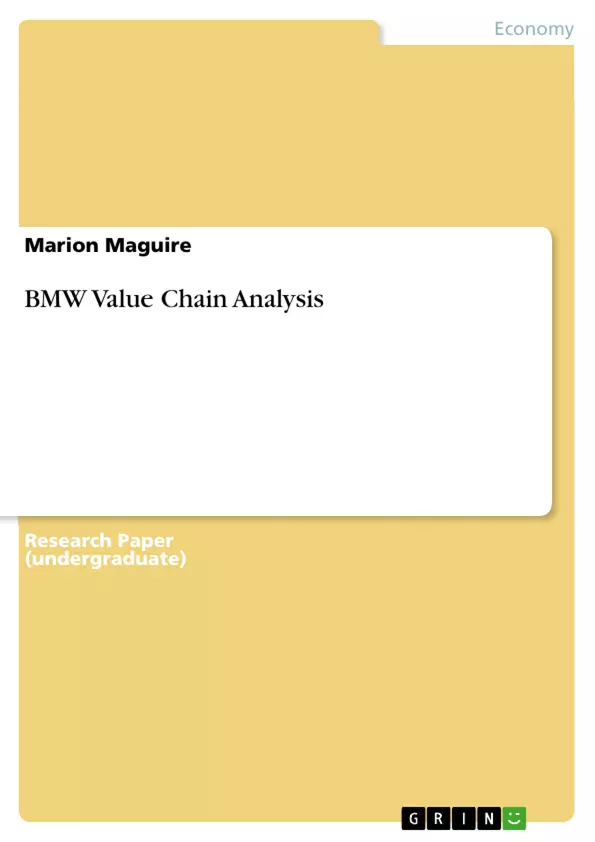This paper will analyze how the German car manufacturer BMW derives value from information systems as well as identify the value chain activities that are affected by the identified information systems. Following analysis will be limited to the information systems that provide the greatest value to BMW in form of gaining or maintaining a competitive advantage.
BMW, which stands for Bayerische Motoren Werke, is a luxury car manufacturer. The headquarters of the BMW group is in Munich, Germany, but the company is present all over the world (BMW Group, 2004). The company built high brand equity over the years through continuous branding efforts and high quality products (Interbrand, 2001). BMW is arguably the most admired carmaker in the world and BMW products inspire near-fanatical loyalty (Kiley, 2004).
Michael E. Porter developed the value chain concept in 1985. Porter’s value chain provides a systematic means of categorizing activities. At each stage of the value chain there exists an opportunity to contribute positively to the firm’s competitive strategy by performing some activity or process in a way that is better than the competitors, and so providing some uniqueness or advantage (Porter, 1985).
Value activities can be divided into two broad types, primary activities and support activities (Porter, 1985). There are five generic categories of primary activities involved in competing in any industry: (a) Inbound Logistics, (b) Operations, (c) Outbound logistics,
(d) Marketing and Sales, and (e) Services (Porter, 1985). Support activities support the primary activities and can be divided in four generic categories: (a) Procurement, (b) Technology Development, (c) Human Resource Management and (d) Firm Infrastructure (Porter, 1985).
Table of Contents
- Introduction
- Overview
- Company Description
- Value Chain Concept
- Discussion
- Information Systems Identified
- Description of Information Systems
- E-business solutions
- ASP solution
- XML technology
- SAP R/3 application
- Value Contribution of Identified Information Systems
Objectives and Key Themes
This paper examines the value chain of BMW, specifically exploring how the company leverages information systems to achieve competitive advantage. It aims to analyze the value chain activities that are most impacted by these information systems and to identify those that contribute significantly to BMW's success.
- The role of information systems in enhancing BMW's competitive advantage
- Analysis of value chain activities impacted by specific information systems
- Contribution of information systems to BMW's overall performance and market leadership
- The impact of information systems on BMW's customer experience and supplier relationships
- Comparison of BMW's information system strategies with its main competitor, Ford
Chapter Summaries
- Introduction: This section provides an overview of the paper's focus on analyzing the value chain of BMW and how information systems contribute to its success. It introduces the company description and a brief explanation of Porter's value chain concept.
- Discussion: This section dives into the specific information systems employed by BMW, highlighting the most valuable ones: e-business solutions, ASP solutions, XML technology, and SAP R/3 application. It then delves into detailed descriptions of each system and their impact on various aspects of BMW's operations, including customer experience, supply chain management, and overall efficiency.
- Value Contribution of Identified Information Systems: This section explores the overall contribution of these information systems to BMW's value chain and its position as a market leader. It examines the role of these systems in enhancing innovation, e-business capabilities, and overall financial performance. This section also compares BMW's performance with its main competitor, Ford, highlighting the benefits of BMW's information system strategies.
Keywords
This paper focuses on the value chain of BMW, information systems, competitive advantage, e-business solutions, ASP, XML, SAP R/3, supply chain management, customer experience, supplier relationships, financial performance, market leadership, and comparison with Ford.
- Quote paper
- Marion Maguire (Author), 2004, BMW Value Chain Analysis, Munich, GRIN Verlag, https://www.grin.com/document/35479



